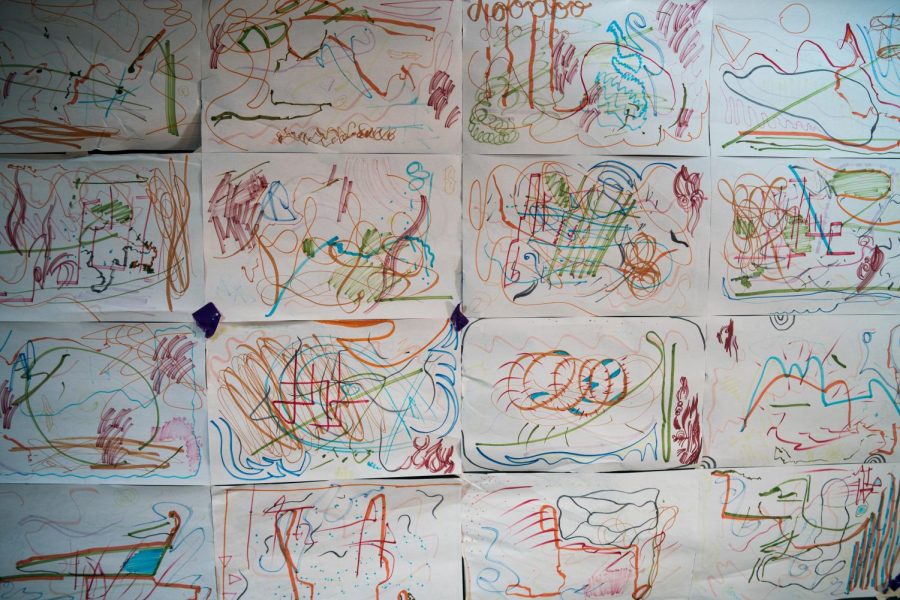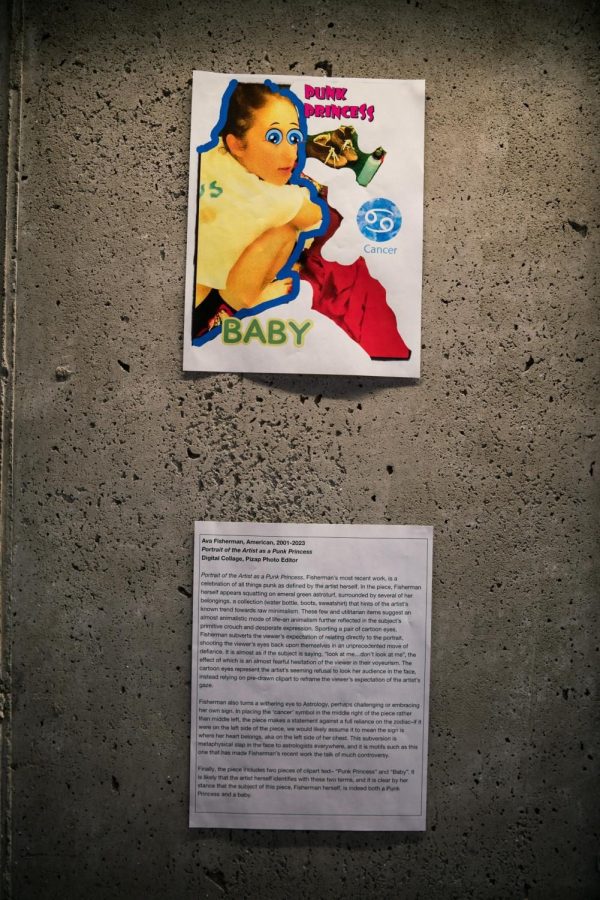BadArtCo Gallery Show Questions Mainstream Values of Art
This past Thursday, the BadArtCo Gallery Show exhibited art created using methods and forms that have conventionally been considered poor.
This past Thursday, the BadArtCo Gallery Show exhibited the Experimental College course’s investigation of terrible art in Birenbaum Innovation and Performance Space. It was a vibrantly experimental event complete with bloody performance art, bad comedy on loop, and effigy burning to a live opera soundtrack.
Everyone has their own notion of what makes art “good art,” and, chances are, that notion has less to do with personal taste and more to do with social and cultural trends. After all, the lens through which we see the world is largely a culturally constructed phenomenon. College fourth-year Henry Wahlenmayer is acutely aware of this fact, so during his second year at Oberlin, he set out to flip the script. This is how BadArtCo, Wahlenmayer’s ExCo brainchild, came about. In many ways, BadArtCo is like an inverted Art History and Studio Art crossover, with the added element of hands-on experimentation. Final projects comprise anything from dissonant music with weird lyrics to a giant hay man with drawn-on tattoos. All in all, Wahlenmayer’s ExCo aims to probe and mimic the smorgasbord that is the contemporary art world, but from the central vantage point of “bad art” with a giant question mark at the end. Members of BadArtCo investigate how, why, and what makes people hate art and then attempt to emulate culturally enshrined definitions of artistic failure in their own work.
Over the course of his two years ideating and teaching the ExCo, Wahlenmayer has developed a fully fleshed out curriculum from which hands-on activities are derived. Wahlenmayer is not an Art History major — his inspiration for BadArtCo began with him and his friends watching the TV show Riverdale and a recurring joke that he would teach an ExCo on “horrible TV.” The bit then snowballed until it wasn’t a joke anymore, and, as Wahlenmayer puts it, he found himself eyeballs-deep in research and critical analysis of what makes “bad art” bad.
“We start all the way back to the Amarna period in ancient Egypt, where there was a pharaoh that took over and decided to completely revamp the artistic style of Egyptian art,” Wahlenmayer said. “Everyone hated it so much that as soon as he died, they destroyed all of the Amarna period art and they went back to the old stuff. That was the earliest example of bad art that I could find… We go up through time all the way to the modern day, and we talk a lot about contemporary art as something that a lot of people think is bad.”
Lessons span from ancient periods to hyper-modern “bad internet culture” and meme-making to “strange art film” iMovies made in 50 minutes. On occasion, these practices and discussions take on a local relevance — from midcentury modern architecture to contact improvisation. Wahlenmayer and his co-teacher of the last two years, College third-year Fiona Giménez-Collins, also bring students on a walking tour of bad art in Oberlin.
“Oberlin art history is really specific and strange because oftentimes the artists here and the artists we host are boundary-pushing people who create spike pits on college campuses,” Wahlenmayer said. “There was a performance artist that visited in the ʼ80s who hung himself naked upside down … Thereʼs just this weird, long history of radical expression at Oberlin. We wanted to kind of tap into that with this class because I think we have gotten a lot more tame as a campus, which is not necessarily a bad thing, but it is kind of fun to provide an atmosphere for people to just do something really wacky and weird, whether thatʼs creating an absolutely unlistenable song or weird performance art.”
College second-year and BadArtCo student Owen Spina finds that the premise of making something bad allows him to engage with art in a more unfettered manner. He reflected on a portion of the class where members interrogated outsider art, a movement of novice or self-taught artists that emerged from 19th-century European psychiatric hospitals.
“I just remember everything being really messy and very flattened,” Spina said. “I was so interested in the class because I take pride in using the tools of bad art in my own stuff, but I think I realized [there are] a lot of the weird gray areas and also learn[ed] more about the quality system of art … for example, outsider art and how itʼs exploitative in a lot of ways, especially how itʼs in the art world.”
College fourth-year Jason McCauley started taking BadArtCo this semester, but as a close friend and current housemate of Wahlenmayer, he has had an insider perspective on the ExCo’s development from its inception. He noted that for each of the ExCo’s years of existence, Wahlenmayer has created a hay-filled effigy, and now they share a roof with the anthropomorphic creation. McCauley finds that BadArtCo provides a unique space for him and his peers to strike a balance between highfalutin discourse and unadulterated silliness.
“Coming from a TIMARA perspective, I’m very much used to things that are challenging what our definition of music is and what our definition of art is,” McCauley said. “I really enjoy the way that the ExCo simultaneously takes a critical or a kind of poking fun eye to some of the art world and those spaces — in terms of, like, liberal arts speak and intellectualism — and then also does engage in it as well. A lot of the discussions that we have is looking at different examples of art and then talking about, do we feel it to be art and then what does that mean?”
For his final BadArtCo Gallery Show piece, McCauley could be seen writhing around in fake blood atop a tarp. Spina likewise contributed a video of an “unprepared” comedy act in Azariah’s Café. At the end of the day, I find myself asking: can art really be bad if it looks this fun?












